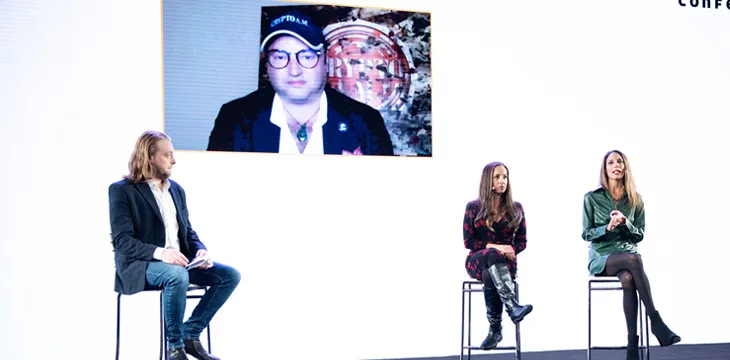|
Getting your Trinity Audio player ready...
|
Blockchain-focused media outlets have a mission to educate the wider public on digital assets while trying to avoid being taken for a ride by pump-and-dump scammers.
Day 2 of the CoinGeek Conference New York brought a panel, titled “Media Influence: How News Reporting Affects the Digital Asset Market.” The panel was moderated by Bitcoin Association’s Head of Communications Alex Speirs, who quizzed a trio of media luminaries: James Bowater – Founder & Editor-at-Large, Crypto AM/City AM’s Crypto Insider; Jill Malandrino – Global Markets Reporter, Nasdaq/Host, Trade Talks; and Rachel Wolfson – Reporter (Cointelegraph), author, public speaker and analyst.
Speirs started the discussion by asking Bowater how media coverage changed as the digital asset’s market cap grew to over $2 trillion. Bowater said that when he started Crypto AM three years ago, he saw his mission as translating what’s going on in ‘crypto world’ to London’s traditional finance sector as well as to the public at large.
Lately, Bowater said much has been made of institutional adoption of digital assets but people forget that “everything is based on regulation.” In the years following Crypto AM’s launch, regulators have begun the process of putting sensible frameworks in place, leading to more institutions feeling more confident about risking clients’ money by investing in digital assets. In the process, “a lot of naysayers have become yeasayers” and are determined not to miss the boat this time.

Nasdaq’s investor focus means Malandrino tackles crypto coverage a little differently than blockchain-specific sites. From monitoring how institutions are adopting crypto in their portfolios to how retail investors can incorporate digital assets into investment plans, Nasdaq takes a holistic approach, educating the investor marketplace rather than focusing on the new project launches constantly vying for media attention.
Wolfson said she’s been focused on enterprise blockchains since 2017 and this area dominates her Cointelegraph coverage. Wolfson doesn’t much care about asset price, focusing instead on enterprise adoption, including how enterprises are using blockchain to improve areas such as supply chain management.
Fake news lurking in your inbox
With digital asset reporters deluged by dozens of crypto-related press releases and story pitches every day, all three panelists stressed the importance of remaining vigilant against news that seems too good to be true.
Malandrino said her experience of reading countless Walmart press releases over the years led her to immediately smell a rat in the infamous ‘Walmart to accept payment in Litecoin’ release that temporarily resulted in a one-third rise in the LTC token’s value. The wording and timing of the release “seemed very suspect” and “just wasn’t indicative of patterns that we follow in releases of companies of that size.”
Wolfson, who focuses on long-form, heavily-researched articles that take a long time to deliver, said her habit of reaching out for additional comments from companies mentioned in releases would not only have prevented her from falling for the LTC pump, it also helps distinguish her articles from those by writers who simply “regurgitate” what they’re sent.
While a number of prominent mainstream media outlets also fell for the LTC scam, given crypto’s always-on/open markets and the lack of a top-down regulator capable of halting trading, Speirs wondered if blockchain media had a higher responsibility to police the truth than media covering traditional financial markets.

Malandrino, who books guests 3-4 weeks in advance so she can do proper research and due diligence, also didn’t fall for the LTC scam. But she noted that such antics aren’t limited to crypto: prop traders in the equity sector trade specifically off headlines, rightly or wrongly willing to take that risk.
What would Spiderman do?
Speirs asked Bowater about Crypto AM’s July report that online giant Amazon was preparing to accept Bitcoin as payment ‘by the end of the year,’ with other tokens to follow. That report, written by Crypto AM editor Darren Parkin, was subsequently denied by the company, which reversed the pump that BTC had enjoyed following Parkin’s talk with an unidentified ‘insider.’
Bowater, who wrote a subsequent article defending Parkin, told Speirs that the original article was “a true, verified story” and he stood behind Parkin’s “research and the conversations he had.” Bowater pointed out that the ensuing Amazon denial appeared to stress the fact that the company had no plans to add crypto payment options “this year.”
Bowater called the whole episode “a pretty horrific situation,” as Parkin received death threats following BTC’s price tumble and “a lot of people lost their shirts.” Bowater added that it “shows the power that people have” and that the maxim of great power coming with great responsibility wasn’t specific to Peter Parker.
As such, Bowater went on to say that blockchain media should insist on “verification of facts wherever possible. If you can’t verify, don’t publish.”
Cutting through the noise
Speirs asked the panelists how they identified stories they deemed sufficiently newsworthy. Malandrino reminded Speirs that crypto was only a part of her focus, but she “looks through the lens of what correlates to what we’re talking about in other areas of the capital markets.” Malandrino cited ESG (environmental, social and governance) as a topic that’s “just everywhere these days,” so she’s likely to give a little more consideration to a pitch about crypto mining’s energy use, for example.
Malandrino also expressed interest in stories that “marry legacy to newer technologies and newer asset classes,” such as a fintech outfit teaming with a mainstream payment processor.
Wolfson concurred, saying she loves getting releases about a start-up working with Visa, Mastercard or some other established firm. To Wolfson, this is evidence that the crypto space is bridging the gap with traditional finance.
Bowater noted that the panel had yet to address the current DeFi or NFT crazes, although Wolfson said she was weary of the volume of NFT PR showing up her in-box, likening it to the ICO mania of a few years ago. Bowater insisted that there were some “merit-worthy” NFT projects, a view that Wolfson supported, although with the caveat that the sheer volume of NFT releases makes it hard to discern which to cover.
Malandrino said NFTs were an example of the digital space’s tendency to “cannibalize itself.” Once something like NFTs catch on, “then everybody has an NFT.” She joked that she should create an NFT of Trade Talk’s first episode, sell it and retire a millionaire, although she doubts that plan will work.
Wolfson agreed that not all NFTs will turn to gold and that people “need to understand the broader story behind NFTs,” which won’t happen so long as the media keeps pumping out ‘get rich’ articles.
What’s missing
Speirs lamented the fact that so much of crypto media focuses almost exclusively on market cap and token price, leading Wolfson to lament the comparative lack of enterprise blockchain coverage. Worse, when sites do cover the enterprise angle, they tend to mention the same blockchains over and over. First it was Hyperledger, then IBM Blockchain, now it’s all ‘enterprise Ethereum.’
Wolfson said attending her first CoinGeek Conference had opened her eyes to the potential of the BSV enterprise blockchain. Wolfson’s articles focus on real-world cases, and she believes BSV deserves more widespread media coverage based on the great uses on display at the New York conference.

Wolfson also believes enterprise adoption will address Bowater’s comment that the digital asset sector was “a very fast moving and very young industry.” While enterprise news might not be as exciting (for some) as price-based reports, enterprise adoption is helping to “mature” the digital asset space, which some observers believe is both necessary and long overdue.
Final words
Despite her annoyance with overstuffed in-boxes, Wolfson said she welcomed releases dealing with enterprise-related material because it alerted her to the existence of companies/technologies on which she can do further research.
Bowater’s advice was for reporters to “just crack on with what we’re all doing, do the research, keep it real, keep it valid, keep it verified. Let’s just make sure we report things sensibly and do things correctly.”
Malandrino ended the session with a shout-out to folks like Bowater and Wolfson, asking them to “keep doing what they’re doing so people like me can leverage the experience of experts.”
Watch CoinGeek New York 2021 Day 2 here:

 09-04-2025
09-04-2025 





